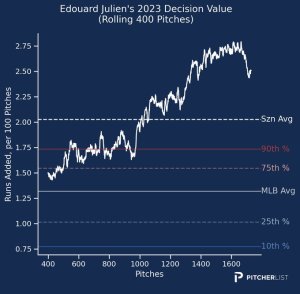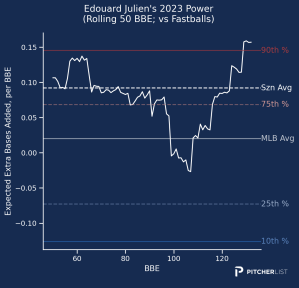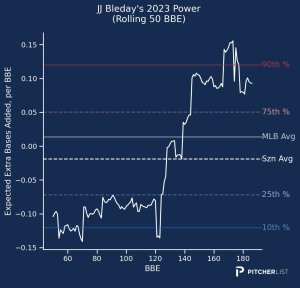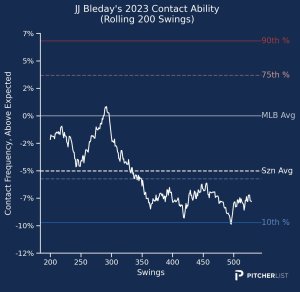Deep down, we all know that batting average is less useful than OBP. OBP was one of the first “advanced” stats that became used in mainstream conversations, and it’s almost impossible to understand a player’s offensive contributions without knowing their OBP. As a result, many leagues have switched over to OBP in lieu of batting average (and if it were up to me, we all would make the switch for all leagues).
Perhaps the most important thing to know when switching to an OBP format is understanding which players gain the most value when you replace batting average with OBP, and in some cases, the players who get a boost will surprise you. Unlike my other articles on players to target, this article will order players by how much they are impacted by switching over in terms of how much value they gain in OBP leagues. I have also included their ADP from NFBC drafts completed on or after February 1. At the conclusion of the piece, I’ll quickly list off some players who lose value in OBP formats.
To see where I’d rank these players in a standard league, check out my Top 300 hitters for 2024.
1. Kyle Schwarber (OF, PHI), ADP 81 – Two seasons in Philly, two straight seasons of setting career highs in home runs (46 in 2022, 47 in 2023). It comes with a .200 batting average, unfortunately, but he’s second in home runs, seventh in runs scored, and ninth in RBI in all of baseball since the start of 2022. If you’re intentionally punting batting average or are in an OBP league, you could easily argue he’s in Tier 4 (of the Top 300)
2. Juan Soto (OF, NYY), ADP 11 – If you’re designing a swing decision model, the best way to test that it works is to see what it says about Soto. If it says he’s amazing, then the model is working. It was great to see Soto hit more home runs than he did in the infamous 2019 rabbit ball season while also getting back to double-digit stolen bases. 2022 was a weird year for him, but the resurgence in 2023 tells us what we already should have known—that 2022 was a fluke.
The most impactful part of the move to New York is the improved home run environment, going from the 10th worst home run park for lefties to the third best. This gives Soto a better shot at finding 40 home runs for the first time in his career if he feels like pulling more fly balls, but I’d say the baseline is still 33-35 home runs with elite ratios. Weirdly enough, Yankee Stadium had the second lowest Expected Home Runs by Park according to Statcast for Soto with 27, tied with Progressive Field and Kauffman Stadium, which are notoriously tough home run parks for southpaws.
3. Max Muncy (3B, LAD), ADP 165 – 2023 was the first time Muncy drove in over 100 runners, and his 36 home runs tied a career high he had set in 2021. The batting average will always stink and his OBP is more neutral than it is positive these days, but another year as the primary third baseman for the Dodgers gives Muncy a top 50 upside. Being 33 years old and never having played in more than 144 games in a season is a bit of a bummer, as is losing the first and second base eligibility he’s had in years past. That said, the replacement level in standard leagues should make covering the 20-30 games he misses a breeze.
4. Joey Gallo (1B/OF, WSH), ADP 646 – Gallo has yet another new home, this time with a fairly clear path to 120 starts as the strong side of a platoon in the outfield with whoever happens to be on the Nats bench at any given moment. That should create a path to 20-25 home runs for Gallo, albeit with his infamous sub-.200 batting average and not-quite-as-awful .310 OBP.
5. Ryan Noda (1B/OF, OAK), ADP 625 – OBP leaguers will love the 15% walk rate and 20 home run power, but playing for Oakland means counting stats are mostly unavailable, and Noda’s high strikeout rate will keep him out of most conversations in batting average leagues.
6. Aaron Judge (OF, NYY) – If Judge plays 140 games, he’s going to hit 45 home runs or more. It’s a given at this point, considering he walloped 37 of them in just 106 games in 2023. The only real concern with Judge is the health, which is a bummer after he spent all of 2021 and 2022 in the lineup. That said, ranking Judge eighth is only happening because of that risk, so don’t take the bait of a “double penalty” and drop him out of this tier in your ranks. The upside is way too high to make that kind of blunder, as there is no better bet to lead the American League (and all of baseball) in home runs than a healthy Aaron Judge.
The addition of Soto to the lineup should also mean more counting stats as the 2023 Yankees were simply dying for a hitter other than Judge (and to a lesser extent, Torres) to help carry their offense.
7. Edouard Julien (2B, MIN), ADP 206 – In his very first exposure to the majors and being only 24 years old, Julien showed he is and will likely continue to be among the best decision-makers in the league (see below) and can punish fastballs.


This is an excellent starting point to launch a successful 2024 season, though it’s worth noting that there are weaknesses in how he performs in both contact and power against breakers and offspeed pitches. That particular weakness isn’t unique to Julien, though, as many young players struggle to adjust against how well major league pitchers can use these weapons compared to minor leaguers. I believe there’s room for Julien to learn how to deal with these pitches, and it could lead to 20 home runs with 90+ runs scored if he can stay at the top of the Twins’ lineup.
8. Jack Suwinski (OF, PIT), ADP 240 – Suwinski has issues with zone contact (which you may have noticed is a red flag for me), but a combination of power, speed, and playing time still led to 26 home runs and 13 steals for the 25-year-old southpaw. Suwinski is much better suited to OBP leagues where his high walk rate can make his ratios more than acceptable, but in standard leagues, you shouldn’t expect more than a .220 average with subpar counting stats as part of a dismal Pirates lineup.
9. JJ Bleday (OF, OAK), ADP 733 – I’ll let the charts tell the story, but I am curious about whether Bleday can hold on to this power along with his decision-making to overcome his limited contact ability.



10. Alex Bregman (3B, HOU), ADP 92 – Bregman’s 2023 closely resembled his 2023 in just about every way, and I expect 2024 to be yet another re-run (not that it’s a bad thing). 20-25 home runs, 180-200 combined runs and RBI, and a .260/.365/.450ish line can be penciled in now and probably gone over in ink by next September.
11. Eugenio Suárez (3B, ARI), ADP 286 – Suárez is no longer the lock for 30 home runs he was from 2018-2022, but assuming the D-Backs intend to deploy Suárez in the middle of their lineup, then he should still drive in 80-90 runners even if the home run total is closer to 20 than it is to 30 despite the ugly batting average (though the OBP isn’t nearly as painful).
12. LaMonte Wade Jr. (1B/OF, SFG), ADP 522 – Wade Jr. was finally mostly healthy for a season, and he returned decent value (good value in OBP leagues) with 17 home runs and 64 runs scored. Wade Jr. should hit near the middle of San Francisco’s lineup, though the quality of that lineup makes it hard to project more than 110-120 combined runs and RBI to go along with 16-18 home run power. The floor is high, but the ceiling is fairly low.
13. Matt Wallner (OF, MIN), ADP 344 – Wallner has a difficult path to a full-time role due to the nature of the Twins roster and his weakness to left-handed pitching, but there’s no doubting his raw power after he hit 14 home runs in 76 games. Keep Wallner in the back of your mind, especially in OBP formats, when you need power at the end of a deep draft or during the season when perusing the wire, but even if Wallner is healthy for all of 2024, it’s unlikely he gets to 120 games played while in a strict platoon.
14. Matt Chapman (3B, FA), ADP 270 – Chapman’s hard-hit rate in 2023 was the best of his career (by a pretty wide margin) despite putting up 10 fewer home runs than he had in each of the last two seasons. Part of the issue may have been luck, as Chapman’s 39 doubles were 12 more than he hit in 2022 and 24 more than he had in 2021, and he also didn’t pull the ball as much as he did in 2022. 25-30 home runs are possible for Chapman no matter where his free agency takes him, but his strikeouts, streakiness, and low batting average will frustrate even the most patient fantasy managers.
15. Lars Nootbaar (OF, STL), ADP 204 – Injuries once again limited Nootbaar to fewer than 120 games in the big leagues, but he still managed to show the power, speed, and on-base skills that caught our attention in 2022. Nootbaar looks like a good fit for the top third of the lineup, and if he can seize that opportunity, we could be looking at 23-25 home runs, 150-160 combined runs and RBI, 13-15 steals, and solid ratios. Those are all dependent on health and lineup position, though, and Nootbaar has yet to show consistency with either, but the upside is very real.
15. Ian Happ (OF, CHC), ADP 156 – Happ gets a boost in OBP leagues thanks to his double-digit walk rates, but even in standard leagues his 20-22 home runs and 12-15 steals should make an impact, especially since they come with over 80 runs and 80 RBI as long as he’s healthy and the Cubs can look anything like the 2023 version of themselves. Happ is mostly just an accumulator who provides everything except batting average, and if you’re in a deeper league or are at a place in your draft where you need a safety net in the outfield, Happ is your guy.
Other players who gain value that I target in OBP leagues: Isaac Paredes, Christian Yelich, Mike Trout, James Outman, Andrew McCutchen, Triston Casas, and Anthony Volpe
Five players who lose the most value when you switch to OBP leagues:

Scott- using NFBC ADP and OBP what hitters would you add to or drop from the first few rounds?
Great question!
1) Matt Olson moves to middle of Round 1
2) Witt and Trea Turner fall to Round 2.
3) Schwarber and Riley slide into the back of Round 1 or early Round 2.
These are probably the “splashiest” impacts in the first 2 rounds.